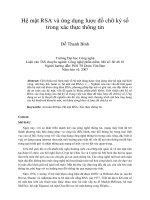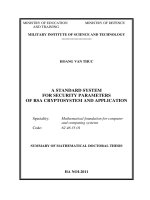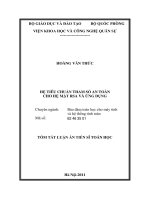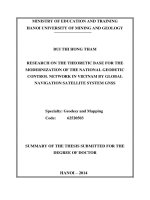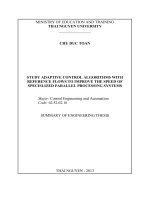hệ tiêu chuẩn tham số an toàn cho hệ mật rsa và ứng dụng bản tóm tắt tiếng anh
Bạn đang xem bản rút gọn của tài liệu. Xem và tải ngay bản đầy đủ của tài liệu tại đây (215.25 KB, 27 trang )
MINISTRY OF EDUCATION
AND TRAINING
MINISTRY OF DEFENCE
MILITARY INSTITUTE OF SCIENCE AND TECHNOLOGY
HOANG VAN THUC
A STANDARD SYSTEM
FOR SECURITY PARAMETERS
OF RSA CRYPTOSYSTEM AND APPLICATION
Speciality: Mathematical foundation for computer
and computing systems
Code: 62 46 35 01
SUMMARY OF MATHEMATICAL DOCTORAL THESIS
HA NOI-2011
THESIS IS COMPLETED AT
MILITARY INSTITUTE OF SCIENCE AND TECHNOLOGY
Supervisors:
1. Dr Leu Duc Tan
2. Asc. Prof. Dr Bach Nhat Hong
Reviewer 1: Asc. Prof. Dr Hoang Van Tao
Government Information Security Commission.
Reviewer 2: Dr Tran Van Truong
Government Information Security Commission.
Reviewer 3: Asc. Prof. Dr Đinh The Cuong
Le Quy Don Technical University
This thesis will be defended at the
board of doctoral
examination - Military Institute of Science and Technology
at
…./…./…./2011
This thesis can be found at:
- Library of Military Institute of Science and Technology.
- National Library of Vietnam
1
INTRODUCTION
As with all other cryptographic primitives, the model and
algorithm structure of RSA cryptosystem are public. However, a
difficult problem is that how selection and use of the system
parameters for this cryptosystem so that it ensures security and
effectiveness.
Thus, security criteria construction for RSA parameters is still
interested by many scientists. Currently, there are many documents
related to this area are published, for example ANSI X9.31, NIST
800-57, FIPS 186-3.
However, along with the development of cryptography science,
cryptanalysis science developed many new attacks to RSA
cryptosystem. Studying the existing security criteria as well as
studying and proposing new security criteria for RSA parameters are
very necessary.
From the above practical requirements, choosing the topic “A
standard system for security parameters of RSA cryptosystem and
application” for studying is reasonable.
Objective of the research
Studying overview to master the knowledge of RSA
cryptosystem and security criteria for the RSA parameters that
have been published in the international standards; proposing
new security criteria for RSA parameters (studying and
supplementing the existing criteria as well proposing new
standards); applying security RSA parameters for the Web
security protocols.
Object of the research
The thesis chooses RSA cryptosystem and the web security
protocol for studying.
2
Contents of research
Study overview of RSA public key cryptosystem.
Study and build the security criteria for RSA parameters
Build and install algorithms to generate security RSA parameters
that satisfy above criteria.
Study to apply the security RSA parameters for the web security
protocols.
Thesis organization
The thesis consists of three chapters, and following sections:
introduction, conclusion, publication list and appendixes.
New research contents of thesis
Propose and supplement quantification for the existing criteria.
Propose new criteria to resist the cycling attack on RSA
cryptosystem.
Constructing, coding the algorithm to generate security RSA
parameters and integrating into the certificate generating
software under the X509 standard.
Modifying Web browser software to ensure security for web
transaction using security RSA parameters.
3
CHAPTER 1
OVERVIEW OF RSA PARAMETER CRITERIA
AND WEB SECURITY PROTOCOLS
To explain the necessary and build a foundation for
implementing the thesis contents, this chapter will present some
results of the related publications.
1.1. DEFINITIONS AND SYMBOLS
Trivial Divisor: Divisors 1, -1, N and -N are called trivial
divisors of the integer number N.
Prime Number: Integer N>1 is a prime number if it has trivial
divisors.
Composite number: Integer N>1 is a composite number if it is
not prime number.
Primality Certificate: Mathematic proof that a given number is
really prime number.
Trial Division: Trial division of N is to check all prime numbers
that are smaller than or equal as N
1/2
to see if they divide N.
Secure strength (secure_strength): A value related to the amount
of work (the number of operations) that is required to crack a
cryptographic algorithm or a cryptosystem. Namely, a cryptographic
algorithm with given parameters is said to have the security level
secure_strength if cracking this algorithm requires at least
2
security_strength
operations.
1
p
,
2
p
,
1
q
,
2
q
are called auxiliary primes.
4
1.2. RSA PUBLIC KEY ENCRYPTION
1.2.1. Key generation algorithm for RSA public key encryption
Step 1: Generate two large random (an distinct) prime p and q;
Step 2: Compute
N pq
,
( ) ( 1, 1)
N lcm p q
;
Step 3: Select integer e,
1 ( )
e N
, such that
gcd( , ( )) 1
e N
;
Step 4: Compute integer d,
1 ( )
d N
, such that
1(mod ( ))
ed N
;
Step 5: RSA public key is (N, e); RSA private key is (N, d);
(N, e, d) is called RSA parameters.
1.2.2. RSA public key encryption primitive
B encrypts a message
*
N
m Z
and A decrypts.
Encryption: B uses public key (N, e) of A and encrypt
(mod )
e
c m N
.
Decryption: A uses his private key (N, d) to decrypt
(mod )
d
m c N
.
1.2.3. RSA signature primitive scheme
Entity A signs a message
*
N
m Z
, entity B check A’s signature
for m
Signature generation: A uses secrete key (N, d) to generate
signature
(mod )
d
s m N
for m.
Signature verification: B uses A’s public key (N, e) to verify A’s
signature for m; B compute
' (mod )
e
m s N
, if m = m' return “valid
signature”, otherwise return “invalid signature”.
1.2.4. RSA-based cryptosystems
Nowadays, in information security applications, they always use
formative RSA public key encryptions and RSA signature schemes.
5
In those schemes, they use set of the message preparation
functions:
* *
{ : }
N N
G g
. Instead of direct calculation on
message m (primitives schemes), they calculate on
( )
x g m
with
gG.
1.2.5. Security of RSA cryptosystem
Security of RSA cryptosystem based on the intractability of the
modulo N factorization problem.
1.3. PRIME NUMBER GENERATION ALGORITHMS
1.3.1. Probabilistic primality tests
The thesis presents two probabilistic primality tests: Miller-
Rabin primality test and Frobenius-Grantham primality test.
1.3.2. Prime number generation methods
1.3.2.1. Using probabilistic tests
The thesis presents two prime number generation methods using
the probabilistic primality tests T: random choice of candidate and
incremental search method.
1.3.2.2. Deterministic prime number generation algorithms
The thesis presents two deterministic prime number generation
algorithms: Shawe-Taylor’s algorithm and Maurer’s algorithm.
1.3.3. Remarks
In two prime number generation methods using the probabilistic
primality tests, random choice of candidate method is guaranteed
to produce uniform chosen k bit primes, but less effective in
practice.
Output primes of Maurer’s algorithm is more diversification than
Shawe-Taylor’s algorithm
6
1.4. CRITERIA FOR RSA PARAMETERS
1.4.1. Criteria for RSA parameters are presented in ANSI X9.31
Criteria for the length of modulus
X9.31 recommends the length of modulus in bits: 1024+256s, s
is integer and s0.
Criteria for primes: p, q
X9.31 presents 07 criteria for primes p and q, to create RSA
modulus.
Criteria for public exponent e
e is positive integer, such that
160
2 2
nlen
e
.
Criteria for private exponent d
d=e
-1
(mod lcm(p-1, q-1)) and such that
512 128
2
s
d
.
1.4.2. Criteria for RSA parameters are presented in FIPS 186-3
and NIST 800-57
Minimum length of RSA modulus
NIST 800-57 recommends the minimum length of RSA modulus
in bits that RSA cryptosystem is secure until the years 2010, 2030
and after 2030
Criteria for primes: p, q
FIPS 186-3 presents 06 criteria for primes p and q, to create RSA
modulus.
Criteria for public exponent e
FIPS 186-3 recommends public exponent e shall be selected
prior to generating the primes p, q and e satisfy: 2
16
< e < 2
256
.
Criteria for private exponent d
FIPS 186-3 recommends private exponent d shall be selected
satisfying d > 2
nlen/2
, and d = e
-1
mod (lcm((p-1), (q-1))).
7
1.4.3. Remarks
In three above introduced standards, only the standard ANSI
X9.31 gives the mathematical foundation for the proposed criteria.
However, along with the time, the model technologies have been
developed. Therefore, study of theory basis to propose the correct
quantification for each standard to be necessary.
1.5. RSA CRYPTOSYSTEM AND WEB SECURE PROTOCOLS
RSA cryptosystem that used in web secure transaction through
SSL/TLS protocol.
1.5.1. Introduction about the SSL/TLS protocols
SSL Protocol is to provide security communication for between
client/server applications.
1.5.2. SSL protocol version 3.0
SSL protocol version 3.0 has four main elements: handshake
protocol, SSL record protocol, SSL alert protocol and SSL Change
Cipher Spec Protocol.
1.5.3. Session key computation in SSL protocol
Session key for communication will be calculated from
elements: ClientHello.random, ServerHello.random, pre_master_secret. In
that pre_master_secret is encrypted under RSA public key
cryptosystem.
1.5.4. RSA cryptology system and secure web service
RSA public key cryptosystem is used in SSL secure protocol
with the aim of authentication and session key establishment.
However, to apply the RSA parameter for high level security of the
web secure protocol, we need to modify some cryptographic
properties of these applications.
8
1.6. CHAPTER 1 CONCLUSIONS
This chapter presented overview of the results of publications in
Viet Nam and on the world related to the contents of thesis that need
to be solved, discussed and evaluated about the advantages and weak
points, proposed the solutions to overcome the weak points to makes
it better than those results, namely:
Based on studying the existing secure criteria for parameters of
RSA cryptosystem to find out the necessary of carrying out, to
improve quantification for the exist criteria, build new criteria to
improve the secure for RSA cryptosystem.
(The building and proposing secure criteria for the RSA
parameters will be presented in chapter 2)
Introduce some prime number generation algorithms and their
properties, choose a reasonable algorithm to build RSA
parameters generation algorithm.
Study SSL/TLS protocol and the role of RSA cryptosystem in
the above secure protocols, evaluate the application ability of
RSA parameters in web application, and then propose the
solutions to build web applications that apply the security RSA
parameter.
(The algorithms construction and implementation to generate
security RSA parameters as well as applying them for web
secure protocol will be presented in chapter 3).
9
CHAPTER 2
BUILDING STANDARD SYSTEM
FOR SECURE PARAMETERS OF RSA CRYPTOSYSTEM
2.1. STUDYING THE EXISTING CRITERIA AND PROPOSING
THE SUPPLEMENTATIONS
2.1.1. The security of RSA cryptosystem with the length of
modulus
Definiton 2.1. "RSA Cryptosystem with the given length of
modulus in nlen bit is said to have secure level secure_strength
(nlen) if using NFS method to factorize modulus, then complexity will
be 2
secure_strength(nlen)
".
Table 2.1: The security of RSA cryptosystem
with the given length of modulus
nlen secure_strength(nlen)
1024 bits 89
1536 bits 106
1792 bits 113
2048 bits 120
Definition 2.2. RSA cryptography system with nlen bit modulus
is secure againsts a given attack if the complexity of this attack is
bigger than 2
secure_strength(nlen)
.
2.1.2. A criterion for the length of RSA modulus
This thesis recommends the minimum length of RSA modulus
with ensuring security until the years 2015, 2020 and 2025 as shown
in Table 2.3
10
Table 2.3: Criteria for the minimum length of RSA modulus
Year nlen
2015 1536 bits
2020 1792 bits
2025 2048 bits
Basis of recommend:
To ensure that RSA cryptosystem can resist a generic attack that
uses NFS algorithm to factorize N.
2.1.3. Criteria for primes p, q
2.1.3.1. Criteria for the prime number generation methods
Primes number p, q and auxiliary primes p
1
, p
2
, q
1
, q
2
are
provable primes.
Basis of proposal:
To ensure the correctness and security of RSA public key
encryption and RSA signature schemes.
2.1.3.2. Criteria for the length of auxiliary primes
The minimum length of auxiliary primes p
1
, p
2
, q
1
, q
2
(related to
the length of modulus) such as in table 2.4:
Table 2.4: The minimum length of the auxiliary primes
nlen n
1
, n
2
, n
3
, n
4
1536 bits 212 bits
1792 bits 226 bits
2048 bits 240 bits
Basis of proposal:
To prevent attacks based on properties of primes p, q: Pollard’s
11
p-1 factoring attack, Williams’ p1 factoring attack and William p1
factoring modification attack.
2.1.3.3. Criteria for the length of the primes p, q
p and q shall be selected randomly and satisfy:
( / 2) 1 / 2
( 2)(2 ) , (2 1)
nlen nlen
p q
Basis of proposal:
To ensure that RSA cryptosystem can resist the attacks based on
factoring algorithms those complexities depend on the length of
prime factors, and improve the effect of the RSA public key
encryption and signature scheme.
2.1.3.4. Criteria for the length of |p-q|
Table 2.5: Criteria for the minimum length of |p-q|
nlen minimum length of |p-q|
1536 bits 668 bits
1792 bits 796 bits
2048 bits 924 bits
Basis of proposal:
This criteria aim at preventing Fermat’s attacks whenever p – q =
c with c small.
2.1.3.5. Criteria for the length of prime factor of |p-q|
Prime factor of |p-q| with the minimum length in bit such as in
Table 2.6.
12
Table 2.6: Criteria for the length of prime factor of |p-q|
nlen n
0
1536 bits 106 bits
1792 bits 113 bits
2048 bits 120 bits
Basis of proposal:
The basis of proposal in ANSI X9.31 showed that the criteria
aim at preventing R. Pinch’s attack.
2.1.4. Criteria for public exponent e and secrete exponent d
2.1.4.1 Current attacks related to the length of e
To minimize computation in encryption and signature
verification we can select a small public exponent, for example e = 3,
65537. However, RSA cryptosystem easy to break such as the ways
that Dan Boneh, Glenn Durfee pointed out.
2.1.4.2. Attacks related to the length of d
Similar to the public exponent, to minimize the computation in
decryption and signature generation, we can select the small private
exponent. However, RSA cryptosystem is easy to be broke through
the attacks such as Wiener’ attack, Boneh and Durfee’s attack.
Boneh and Durfee’s attack is successful if satisfy the following
inequality:
1 2
7 1
1 6
6 3
, with
e N
and
d N
.
2.1.4.3. Criteria for e and d
The length of public exponent e at least 32 bit.
The private exponent satisfies
0.82
d N .
13
Basis of proposal:
To prevent the attacks mentioned in 2.1.4.1 and 2.1.4.2.
2.2. NEW CRITERIA AGAINST CYCLING ATTACS
2.2.1. RSA period and its properties
Definition 2.3. The least integer t>0 such that (mod )
t
e
m N m
called RSA period of m and denoted by per(m).
Property 2.1. let t=per(m), if
'
t
e
m
(mod N)
m, then t is divides t'.
Lemma 2.2. let
*
N
m
and
N
a ord m
, then we have:
( )
a
per m ord e
Property 2.2. let M divides N. When with all
*
N
m
we
have: |
M N
ord m ord m
Provableness of the Properties 2.1, 2.2 and Lemma 2.2 presented
detail in the thesis.
2.2.2. New criteria against cycling attack
Cycling attack
Input:
*
N
m
;
Output: c satisfy (mod )
e
c N m
;
Algorithm:
Step1: z
m;
Step2: c
z;
Step3: z
c
e
(mod N);
Step 4: if (z≠m) goto step 2;
Step 5: output c;
To be able to prevent the above attack, RSA parameters need be
selected such that
*
: ( )
N
M m per m B
with B small enough
is rarely. To acchieve this we can based on the result of Lemma 2.3.
14
Lemma 2.3. Let
1
p
and
1
q
are prime factors of
1
p
và
1
q
;
11
p
and
11
q
are prime fators of
1
1
p
and
1
1
q
;and
11
p
,
11
q
>B.
When select e such that
1
p
ord e
multiple of
11
p
and
1
q
ord e
multiple
of
11
q
then we have:
*
1 1
1
Prob : ( )
N
m per m B
p q
To prove the Lemma 2.3 (based on the Properties 2.1, 2.2 and
Lemma 2.2) presented detail in the thesis.
From the result of clause 2.3 we can propose the following
criteria to assure that RSA public key encryption can prevent the
cycling attack.
Criteria for the minimum length of p
11
, q
11
The minimum length of primes factors p
11
, q
11
of p
1
-1, and q
1
-1
as shown in table 2.7.
Table2.7:The minimum length of p
11
, q
11
nlen n
5
, n
6
1536 bits 106 bits
1792 bits 113 bits
2048 bits 120 bits
Criteria for the public exponent e
1
p
ord e
are multiple of
11
p
and
1
q
ord e
are multiple of
11
q
2.3. SECURE CRITERIA FOR PROPOSED RSA PARAMETERS
Following are the collection of secure criteria for the RSA
parameters proposed in this chapter.
15
Criterion N1 (criteria for the length of modulus):
The minimum length of RSA modulus that RSA cryptosystem until
secure by the years 2015, 2020 and 2025 as shown in Table 2.3
Criterion PQ1 (the first criterion for the primes p, q):
Primes number p, q and auxiliary primes p
1
, p
2
, q
1
, q
2
are
provable primes.
Criterion PQ2 (the second criterion for the primes p, q):
The minimum length of auxiliary primes p
1
, p
2
, q
1
, q
2
as shown
in table 2.4
Criterion PQ3 (the third criterion for the primes p, q):
p and q are selected randomly and satisfy:
( / 2) 1 / 2
( 2)(2 ) , (2 1)
nlen nlen
p q
Criterion PQ4 (the fourth criterion for the primes p, q):
The minimum length of |p-q| as shown in table 2.5.
Criterion PQ5 (the fifth criterion for the primes p, q):
Prime factor of |p-q| with the minimum length in bit as shown in
Table 2.6
Criterion PQ6 (the sixth criterion for the primes p, q):
The minimum length of primes factors p
11
, q
11
of p
1
-1, and q
1
-1
as shown in table 2.7
Criterion D1 (criteria for the private exponent d)
The minimum length of the private exponent d as shown in table
2.13.
16
Table 2.13: Criterion D1
nlen Minimum length of d
1536 bits 1260 bits
1792 bits 1470 bits
2048 bits 1680 bits
Criterion E1 (the first criterion for the public exponent e)
The length of public exponent e at least 32 bit.
Criterion E2 (the second criterion for the public exponent e)
1
p
ord e
is multiple of
11
p
and
1
q
ord e
is multiple of
11
q
.
2.4. CHAPTER 2 CONCLUSIONS
In this chapter researched and proposed the criteria for RSA
parameters to improve the security and effectiveness in using RSA
cryptosystem. Criteria were built based on:
Researching and evaluating the secure of RSA cryptosystem
with the related attacks to propose the existing criteria (08
criteria). Especially, thesis proposed four new quality criteria:
N1, PQ2, D1 and E1.
Building new criteria, a criterion for primes p, q (PQ6) and a
criterion for the public exponent e (E2), ensuring that for RSA
public key encryption can resist cycling attack.
17
CHAPTER 3
SECURITY RSA PARAMETERS GENERATION AND
INTEGRATING THEM INTO WEB SECURE SERVICES
3.1. SECURITY RSA PARAMETERS GENERATION ALGORITHMS
In the algorithms we use following symbols:
level: can receive one of three values 0, 1 or 3 that are equal to
RSA modulus length are 1536 bit, 1792 bit and 2048 bit.
Dlen: the length of private exponent d.
dist = |p-q|.
In order to ensure that the algorithm will be successful, following
conditions need to be satisfied:
n
0
+ n
1
> plen/2 and n
0
+ n
2
> qlen/2.
n
0
+ n
1
+ n
2
plen - log
2
(plen) - 2 and n
0
+ n
3
+ n
4
qlen -
log
2
(qlen) - 2.
n
0
< nlen - dlen.
3.1.1. The constants and functions are used in the algorithms
SS[3] = {106; 113; 120}.
Dlen[3] = {1260; 1470; 1680}.
PQlen[3] = {768; 896; 1024}.
random(x) generate random integer y (0, x-1].
3.1.2. SinhP algorithm (the first prime generation algorithm)
3.1.2.1. Algorithm 3.1
Input: level;
Output: p, p
0
, p
1
, p
11
;
Return value: generates p successful return 1, otherwise return 0.
Algorithm:
Step1: Set plen = PQlen[level]; s = SS[level]; dlen =
Dlen[level]; condlen=log
2
(plen)+2; res = 0;
Step 2: Compute n
0
= s + random(2*plen - dlen - 128);
18
Step 3: Compute n
1
= 2s + random(plen - condlen - n
0
- 4s -1), if
(n
0
+n
1
)
plen/2 return step 2;
Step 4: Compute n
2
= 2s + random(plen-2s - n
0
- n
1
- condlen - 1)
Step 5: Generate prime
0
p
with the length n
0
bit;
Step 6: Generate prime
1
p
with the length n
1
bit and
1
1
p
has
prime factor such that
11 1
p
p ;
Step 7: Generate prime
2
p
with the length n
2
bit;
Step 8: Generate an random integer:
1
2 2 1,2 1
plen plen
x
;
Step 9: Choose y within
2
1,
p
such that
0 1 2
1 (mod )
yp p p
;
Step 10: Compute
0 1 0 1 2
(2 )/(2 )
t yp p x p p p
; counter = 0;
Step 11: If
2 0 1
2( ) 1 2
plen
tp y p p then get
1
0 1 0 1 2
(2 ( 2)(2 ) ) /(2 )
plen
t yp p p p p
;
Step 12: Compute
2 0 1
2( ) 1
p tp y p p
; counter = counter+1
Step 13: Generate random integer
2, 2
a p
;
Bước 14: Compute:
a.
2 1
2( )
mod )
(
tp y p
u a p
;
b.
2 0
2( )
(mod )
tp y p
p
v a
;
c.
2 1 0
2( )
(mod )
tp y p p
p
z a
;
Step 15: If gcd (u – , p) = 1 and gcd(v – 1 , p) = 1 and
1
z
then
get res = 1 and goto step 17;
Step 16: If counter<8plen then get t = t + 1, goto step 11;
Step 17: output (q, q
1
, q
11
) and return res;
3.1.2.2. Algorithm 3.1 analysis
With detailed algorithm 3.1 analysis we have following decision:
19
Interger p in output of algorithm is prime.
p
1
is prime factor of p-1 and p
2
is prime factor of p+1
3.1.3. SinhQ algorithm (the second prime generation algorithm)
3.1.3.1. Algorithm 3.2
Input: level, p, p
0
;
Output: q, q
1
, q
11
;
Return value: generates q successful return 1, otherwise return 0;
Algorithm:
Step 1: Set qlen = PQlen[level]; s = SS[level];
condlen=log2(qlen)+2; n
0
= log
2
(p
0
), dist=2
(qlen)-100
, res = 0;
Step 2: While ((n
0
+n
3
)
plen/2) get n
3
= 2s + random(qlen - 4s -
n
0
- condlen - 1);
Step 3: Compute n
4
= 2s + random(qle -2s - n
0
- n
3
- condlen - 1)
Step 4: Generate prime
1
q
with the length n
3
bit and
1
1
q
has
prime factor is
11 1
q q
;
Step5: Gemerate prime
2
q
with the length n
4
bit;
Step 6: Generate a random integer:
1
2 2 1,2 1
qlen qlen
x
Step 7: Choose y within
2
1,
q
such that
0 1 2
1 (mod )
yp q q
;
Step 8: Compute
0 1 0 1 2
(2 )/(2 )
t yp x p
q q q
; counter = 0;
Step 9: If
2 0 1
2( ) 1 2
qlen
tq y p q get
1
0 1 0 1 2
(2 ( 2)(2 ) ) /(2 )
qlen
t yp p
q q q
;
Step 10: counter=counter + 1;
2 0 1
2( ) 1
q tq y p q
; if |p-q|
dist to implement:
a. If counter > 8qlen jump to step 15;
b. Set t = t + 1 and return step 9;
Step 11: Random generating integer
2, 2
a q
.
20
Step 12: Compute:
a.
2 1
2( )
(mod )
tq y q
u a q
;
b.
2 0
2( )
(mod )
tq y p
v a q
;
c.
2 1 0
2( )
(mod )
tq y q p
z a q
;
Step 13: If gcd(u – 1 , q) = 1 and gcd(v – 1 , q) = 1 and
1
z
get res = 1 and goto step 15;
Step 14: If counter
8qlen get t = t + 1 and goto step 9;
Bước 15: give output (q, q
1
, q
11
) and return res;
3.1.3.2. Algorithm 3.2 analysis
Algorithm 3.2 analysis the same with algorithm 3.1 analysis, we
have following affirmation:
Integer q generated by algorithm 3.2 is prime number.
q
1
is prime factor of q - 1 and q
2
is prime factor of q +1.
3.1.4. Properties of primes p, q
Using algorithms 3.1 and 3.2 to generate primes p, q, these
primes will satisfy 06 criteria (from PQ1 to PQ6) as presented in
chapter 2.
3.1.5. SinhED algorithm
3.1.5.1. Algorythm 3.3
Input: level, elen, p, q, p
1
, q
1
, p
11
, q
11
;
Output: e, d;
Algorithm :
Step 1: Set dlen = Dlen[level];
Step 2: Choosing random odd integer elen bit
e
satisfy:
gcd((p-1), e) = 1 và gcd((q-1),e) =1;
Step 3: If
1 11
( 1)/
1
mod 1
p p
e p
or
1 11
( 1)/
1
mod 1
q q
e q
goto step
2;
Step 4: Compute d = e
-1
mod lmc((p-1),(q-1));
21
Step 5: If
2
log ( )
d dlen
goto step 6, otherwise goto step 2;
Step 6: Output e, d;
3.1.5.2. Algorithm 3.3 analysis
Public exponent e and private exponent d are generated by
algorithm 3.3 satisfy E2 and D1 criteria.
3.1.6. SinhThamSo algorithm
3.1.6.1. Algorithm 3.4
Input: level, elen;
Output: N, e, d;
Algorithm:
Step 1: If
{0,1,2}
level
return 0 and exit;
Step 2: If elen < 32 return 0 and exit;
Step 3: Using algorithm 3.1 to generate prime p (SinhP
algorithm);
Step 4: Using algorithm 3.2 to generate prime q (SinhQ
algorithm);
Step 5: Compute N = pq;
Step 6: Using algorithm 3.3 to generate public exponent e and
private exponent d (SinhED algorithm);
Step 7: Output is (N, e, d) and return 1;
3.1.6.2. Algorithm 3.4 analysis
Step 1 of the assured criterion N1 satisfied
Step 2 of the assured criterion E1 satisfied.
3.2. SECURITY RSA PARAMETERS GENERATION
IMPLEMENTATION
Algorithms presented in part 3.1 was implemented in Visusal
C++ 6.0 using Miracle 2.1 sofware.
22
3.2.1. Some auxiliary functions for security RSA parameters
generation algorithm
Maurer’s algorithm: Provable_Gen().
Prime p generation algorithm: SinhP()
Prime q generation algorithm: SinhQ()
Public and private exponent generation algorithm: SinhED()
RSA parameter generation algorithm: SinhThamSo()
3.2.2. Results
The program runs on PC desktop Dell Optiplex 2100L with the
configuration: CPU Intel Pentium IV 3 GHz, 256 Mb RAM. To
generate each modulus length is 100 set, the running time shown in
Table 3.2.
Table 3.2: security RSA parameters generating runtime
Generating time (second) Modulus
length
(bit)
Fastest Slowest
Total Average
1536 8 234 8234 82,34
1792 11 530 14493 144,93
2048 20 641 29447 294,47
23
3.2.3. Primality evidences
The program store primes p, q p
0
, p
1
, p
2
, q
1
, q
2
as well as the
primality evidences of these prime numbers.
3.3. APPLICATION OF SECURITY RSA PARAMETERS
3.3.1. Integrating the security RSA parameters generation into
the certificate generating program
To propagate the security RSA parameters in practical, this thesis
integrate the RSA parameters generation algorithm into the open
source of certificate generation program, OpenSSL v 0.9.8.
3.3.2. Using security RSA parameters for the web security
protocol
The thesis chooses the Apache software version 2.2.15 and
Mozilla Firefox software version 3.6 to develop and apply security
RSA parameters.
3.4. CHAPTER 3 CONCLUSIONS
To apply criteria for security RSA parameters, this chapter of the
thesis has done:
Building and proving the correctness of RSA parameters
generation algorithms that satisfy all proposed secure criteria,
while documents of the criterion PQ5 wrote that “this seems to
be impossible to satisfy”.
Implementing and intergrating the algorithm into X509
certificate generation program.
Researching, modifying the source code of the web explorer
open source that security RSA parameters can be applied to web
security transaction.


